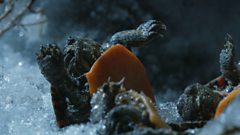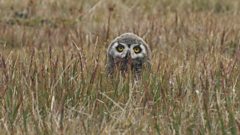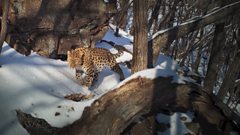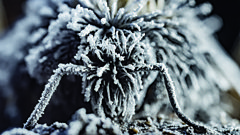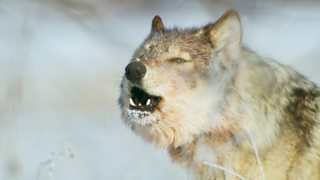Frozen Lands
In the far north of our planet lie vast frozen lands of snow-covered forest and open tundra. These are lands of extremes that push animals to their very limits.
In the far north of our planet lies the largest land habitat on earth, home to snow-covered forests and the icy open tundra. These are lands of extremes that push animals to their limits: in winter they are so cold that much of the ground has remained frozen since the last ice age. To stand any chance of survival, animals must adapt in extreme ways: here a super pack of wolves, 25 strong, has come together to take on the only large prey available to them in winter, American bison.
On the featureless tundra, an Arctic fox must strike a living alone. She is a wanderer and will roam many hundreds of miles searching for tiny lemmings, hidden deep underground. The only way to reach them is with a head dive. In the remote far east of Russia, a rare Amur leopard prowls the seemingly empty, snow-covered forest. With little prey available, it must use its ingenuity to find a meal. It follows crows in the hope of finding carrion, but it must not stay long, for it shares the forest with a far larger but equally hungry big cat, the Siberian tiger.
As spring arrives, the forests begin to thaw and life returns. Beneath the ground, a nest of tiny painted turtle hatchlings now emerge, having remained frozen in a state of suspended animation throughout winter. To the north, it is a further month before the sun’s warmth baths the frozen ground of the tundra. Tucked away underground lies a tiny snow queen – a Lapland bumble bee. She is the sole survivor of her colony - the rest perished in the winter freeze - but her larger size, her furry body and antifreeze in her blood have allowed her to survive. Now she is in a hurry. She must feed herself and raise a brood in the brief window of summer while the flowers are in bloom.
Snowy owls also use the open tundra to breed: one pair have raised a nest full of fluffy chicks. With 24-hour daylight in which to hunt, the dedicated parents bring back meal after meal for their ever-growing brood. But one day, they return to find the nest empty…
Today, the biggest challenge in the tundra is climate change. Warming summers are melting the permafrost deep within the soil, causing the ground to thaw and, in places, the land to collapse. These changes are impacting the animals too. Caribou arrive in herds of 200,000 individuals to raise their calves in the rich pastures, but warming means mosquitos emerge sooner and bother the calves before they have had a chance to gain strength. The parents drive their young to cooler, mosquito-free land, but to get there they must cross rivers running with increased meltwater and escape hungry grizzly bears. They, like much of the tundra's wildlife, are adapted to live in the extremes - but the challenge of today’s warming climate could be one extreme too many.
Last on
More episodes
Previous
Clips
-
![]()
Painted turtles thaw after a long winter
Duration: 02:57
-
![]()
Alaskan snowy owls raise their chicks
Duration: 03:12
-
![]()
The rare Amur leopard
Duration: 03:28
-
![]()
A snow queen waits to make her appearance
Duration: 01:55
Credits
| Role | Contributor |
|---|---|
| Presenter | David Attenborough |
| Producer | Jane Atkins |
| Series Producer | Elizabeth White |
| Executive Producer | Mark Brownlow |

